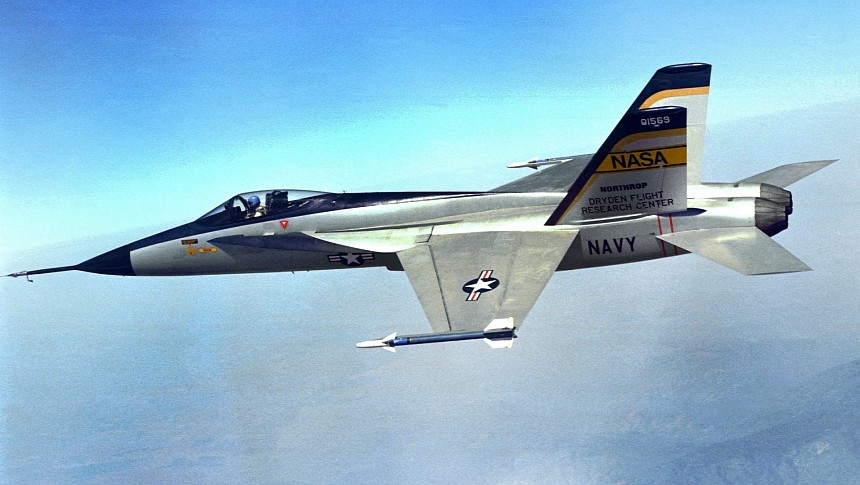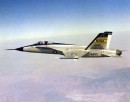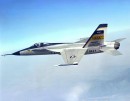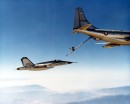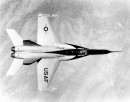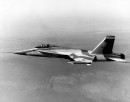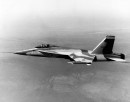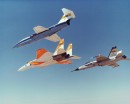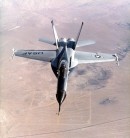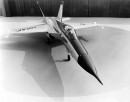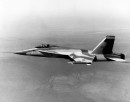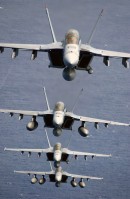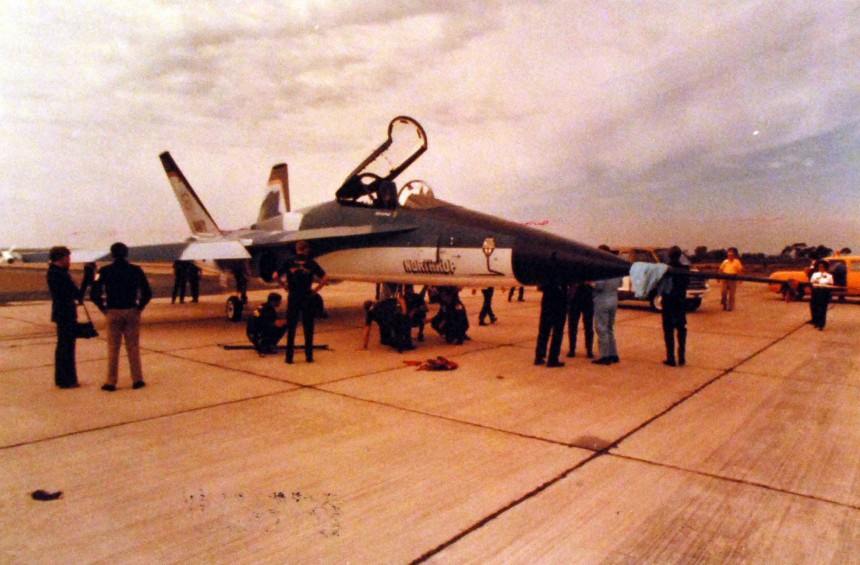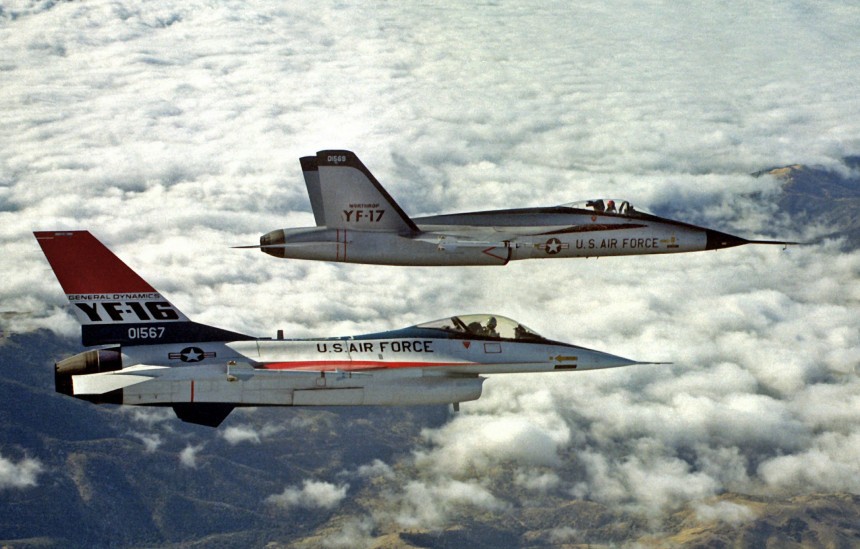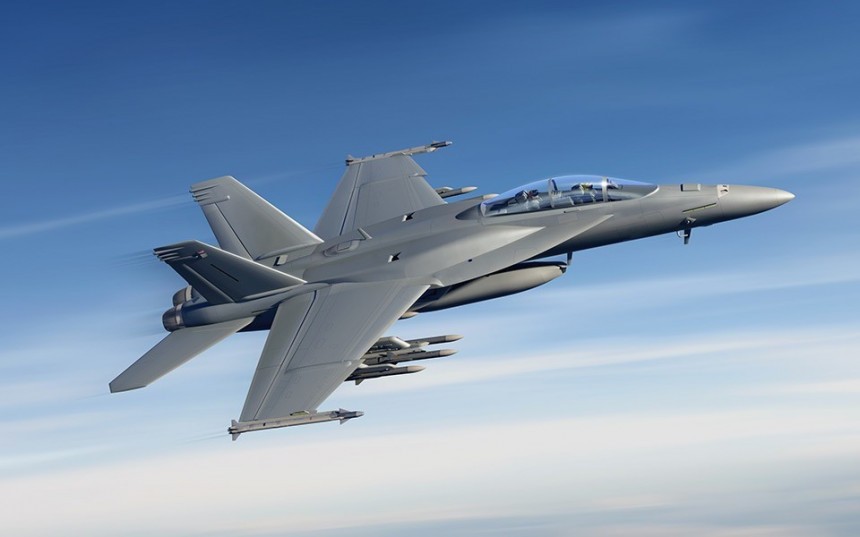The legacy of the McDonnell Douglas F/A-18 Hornet will one day, possibly sometime soon, come to a close. When both the Hornet and the Super Hornet finally leave the decks of aircraft carriers across the globe, the world will look back on the platform as one of the most powerful carrier fighters ever to jump off a set of blueprints and reach reality. It may not be a fraction as visually pleasing as a Tomcat, but then again, almost nothing else is.
In order to trace the heritage of the F/A-18 platform back to its most primordial routes, you have to slip the bounds of the McDonnell-Douglas altogether to an entirely different aerospace manufacturer. That, of course, would be one-half of the current aerospace mega-giant Northrop Grumman, Northrop Aviation. This is the story of the Northrop YF-17 Cobra, the long-forgotten forbearer of the mighty F/A-18.
As the late 1960s came to a close and the harsh lessons of the air war over Vietnam became apparent to the Pentagon, it was clear a new strategy was needed for U.S. air doctrine going forward. During Vietnam, large and cumbersome F-4 Phantom IIs, F-8 Crusaders, and F-105 Thunderchiefs learned the hard way how smaller, more maneuverable MiG 17s, 19s, and 21s could give U.S. pilots all the hell they could handle. Even before the worst days of the air conflict over Vietnam, Northrop Aviation appeared ready to provide a powerful, lightweight airframe capable of dogfighting Soviet MiGs and winning.
This design concept was dubbed the N-102 Fang. Although it never left the drawing board, key elements of the Fang's design, like the all-moving tail stabilizers, became key features of future Northrop designs. What the U.S. Air Force required was a fast, maneuverable, and lightweight jet fighter airframe powered by either one or two turbojet engines. If the F-4 Phantom II was a brick with wings, what became the Lightweight Fighter Program (LWF) intended to produce the exact opposite?
Or, from another perspective, if the third-generation of jet fighters were like flying pickup trucks, the Air Force needed gen-IV jets to be like Ferraris with wings. In total, five major aerospace manufacturers were selected to submit design proposals for the LWF initiative. But through their work designing the F-5, Northrop Aviation was well suited to giving the Air Force what it wanted. If not for its paltry range without drop tanks, the F-5 was almost good enough to take on the LWF program itself. Even so, it's clear a fair amount of F-5 DNA made its way into Norhtrop's entry into the LWF program, originally dubbed the P-530.
With dimensions of 55.5 feet (16.92 m) long and a 35-foot (10.67-m) wingspan with a maximum takeoff weight of 30,630 lb (13,894 kg), the Cobra was a fraction the size of then-contemporary fighter jets like the F-4 Phantom II. Ample use of lightweight aluminum arranged in a semi-monocoque configuration ensured the Cobra's airframe was strong enough for sustained high-G maneuvers while also being light enough to square up to Soviet MiGs.
Similarly, the engines that powered the YF-17 are the polar opposite of the Phantom II's. Weighing in at just over 1,900 lbs (862 kg) per engine, the General Electric YJ101 that powered the YF-17 was almost exactly half the weight of the Phantom's General Electric J-79. With thrust figures of 14,400 lbs (64 kN) per engine, the YF-17's twin YJ101s were a bit like a Toyota 2JZ engine, while the Phantom's J79 engine was like a late 60s HEMI muscle car. So to say, the YJ101s were lighter, more fuel efficient, and arguably more desirable as a result, but still capable of big power.
In fact, the YF-17's engines were only 20 percent or so less powerful than the J79. When Northrop first test flew the YF-17 on June 9th, 1974, out of Edwards Air Force Base in California, it became obvious how much of a benefit these twin beefcakes of powerplants the new design had truly been. A peak speed of 1,500 mph (2,414 km/h, Mach 1.95) was achieved during the Cobra's flight test regimen. It could even achieve supersonic speeds at high altitudes without using the afterburners for sustained periods, an ability known as supercruise.
The airframe's partial fly-by-wire control surfaces were also noted to be quite effective, especially compared to the semi-truck with wings that the F-4 Phantom II was. Add in a weapons suite consisting of heat-seeking AIM-9 Sidewinder and radar-guided AIM-7 Sparrow missiles, and the YF-17 was a formidable air superiority machine. If all else failed, the YF-17 sported a single M61 Vulcan 20 mm Gatling gun in place of the F-5's twin M39A2 revolver cannons. Even by semi-contemporary standards, that's not too shabby of a weapons loadout.
On paper and in practice, it looked like Northrop's YF-17 could have been a marvelous jet fighter. One that the Air Force should have been all too happy to accept. But that's not what happened at all, all thanks to the other half of the Lightweight Fighter program. You know it, you love it, and Air Forces around the world, almost 50 years after the fact, still crave them; it's the General Dynamics F-16 Fighting Falcon. The brainchild of the aeronautical savant and Flint, Michigan native Harry Hillaker, the original YF-16 became the foundation on which several nations formed the backbone of their respective air power.
With the added benefit of General Dynamics personnel who previously worked with McDonnell Douglas on the F-15 program, development time on the F-16 was able to be greatly expedited. Enough so that the first YF-16 was ready to compete with the Northrop YF-17 on time instead of having a much longer development time than typical jet fighters necessitated. Against that kind of historic competition with the added bonus of a less costly single-engine arrangement, the Air Force opted to put the YF-16 into production over the YF-17.
And thus, before the program could truly flourish, the YF-17 program came to an end. In fact, the "Cobra" designation often associated with the YF-17 was only an unofficial moniker, as the prototype had yet to be assigned an official name by the Air Force. In most cases, that would have been the end of the story for the YF-17 Cobra. Except, this time, we actually get a happy ending. You see, American aerospace engineers back in the mid-to-late 20th century tended to bounce around between different companies more than they do today.
That's something of a given, considering there are only two or three major military aerospace firms left in America right now; Lockheed Martin, Northrop Grumman, and Boeing. The rest were long ago swallowed up by larger, more powerful firms. What this means in relation to the YF-17 is simple. Northrop Aviation and the aforementioned makers of the F-15. McDonnell Douglas had a working relationship even before the beginning of the lightweight fighter program.
The partnership stretches back as far as the 1930s when the then-Douglas Company supplied parts and personnel for Northrop's eponymous founder and leading man Jack Northrop. On the back of the successful F-15 program, McDonnel-Douglas enlisted the help of Northrop to help design the YF-17. Not for the Air Force this time, but rather the Navy, who preferred a twin-engine configuration for carrier-based operations. Under the pretext of the Navy's Naval Fighter Attack Experimental (VFAX) program, the YF-17's airframe was slightly enlarged.
It was also given more powerful engines and fitted with an avionics and weapons suite suited not just for air superiority but also for ground and sea-based targets. In November 1978, four years and change after the first flight of the YF-17, the F/A-18A Hornet took to the skies above Naval Air Station Patuxent River in Maryland. Seventeen years later, in 1995, the upgraded F/A-18 Super Hornet was first flown. Thus completing a lineage of jet fighters that lives on until the present day.
So long as the Super Hornet remains in service, this historic line of jet fighters won't fade into the good night just yet. There's at least a decent amount of fighting spirit left in those old Hornets and Super Hornets. But always remember, none of it would've been possible without the YF-17.
As the late 1960s came to a close and the harsh lessons of the air war over Vietnam became apparent to the Pentagon, it was clear a new strategy was needed for U.S. air doctrine going forward. During Vietnam, large and cumbersome F-4 Phantom IIs, F-8 Crusaders, and F-105 Thunderchiefs learned the hard way how smaller, more maneuverable MiG 17s, 19s, and 21s could give U.S. pilots all the hell they could handle. Even before the worst days of the air conflict over Vietnam, Northrop Aviation appeared ready to provide a powerful, lightweight airframe capable of dogfighting Soviet MiGs and winning.
This design concept was dubbed the N-102 Fang. Although it never left the drawing board, key elements of the Fang's design, like the all-moving tail stabilizers, became key features of future Northrop designs. What the U.S. Air Force required was a fast, maneuverable, and lightweight jet fighter airframe powered by either one or two turbojet engines. If the F-4 Phantom II was a brick with wings, what became the Lightweight Fighter Program (LWF) intended to produce the exact opposite?
Or, from another perspective, if the third-generation of jet fighters were like flying pickup trucks, the Air Force needed gen-IV jets to be like Ferraris with wings. In total, five major aerospace manufacturers were selected to submit design proposals for the LWF initiative. But through their work designing the F-5, Northrop Aviation was well suited to giving the Air Force what it wanted. If not for its paltry range without drop tanks, the F-5 was almost good enough to take on the LWF program itself. Even so, it's clear a fair amount of F-5 DNA made its way into Norhtrop's entry into the LWF program, originally dubbed the P-530.
Similarly, the engines that powered the YF-17 are the polar opposite of the Phantom II's. Weighing in at just over 1,900 lbs (862 kg) per engine, the General Electric YJ101 that powered the YF-17 was almost exactly half the weight of the Phantom's General Electric J-79. With thrust figures of 14,400 lbs (64 kN) per engine, the YF-17's twin YJ101s were a bit like a Toyota 2JZ engine, while the Phantom's J79 engine was like a late 60s HEMI muscle car. So to say, the YJ101s were lighter, more fuel efficient, and arguably more desirable as a result, but still capable of big power.
In fact, the YF-17's engines were only 20 percent or so less powerful than the J79. When Northrop first test flew the YF-17 on June 9th, 1974, out of Edwards Air Force Base in California, it became obvious how much of a benefit these twin beefcakes of powerplants the new design had truly been. A peak speed of 1,500 mph (2,414 km/h, Mach 1.95) was achieved during the Cobra's flight test regimen. It could even achieve supersonic speeds at high altitudes without using the afterburners for sustained periods, an ability known as supercruise.
The airframe's partial fly-by-wire control surfaces were also noted to be quite effective, especially compared to the semi-truck with wings that the F-4 Phantom II was. Add in a weapons suite consisting of heat-seeking AIM-9 Sidewinder and radar-guided AIM-7 Sparrow missiles, and the YF-17 was a formidable air superiority machine. If all else failed, the YF-17 sported a single M61 Vulcan 20 mm Gatling gun in place of the F-5's twin M39A2 revolver cannons. Even by semi-contemporary standards, that's not too shabby of a weapons loadout.
With the added benefit of General Dynamics personnel who previously worked with McDonnell Douglas on the F-15 program, development time on the F-16 was able to be greatly expedited. Enough so that the first YF-16 was ready to compete with the Northrop YF-17 on time instead of having a much longer development time than typical jet fighters necessitated. Against that kind of historic competition with the added bonus of a less costly single-engine arrangement, the Air Force opted to put the YF-16 into production over the YF-17.
And thus, before the program could truly flourish, the YF-17 program came to an end. In fact, the "Cobra" designation often associated with the YF-17 was only an unofficial moniker, as the prototype had yet to be assigned an official name by the Air Force. In most cases, that would have been the end of the story for the YF-17 Cobra. Except, this time, we actually get a happy ending. You see, American aerospace engineers back in the mid-to-late 20th century tended to bounce around between different companies more than they do today.
That's something of a given, considering there are only two or three major military aerospace firms left in America right now; Lockheed Martin, Northrop Grumman, and Boeing. The rest were long ago swallowed up by larger, more powerful firms. What this means in relation to the YF-17 is simple. Northrop Aviation and the aforementioned makers of the F-15. McDonnell Douglas had a working relationship even before the beginning of the lightweight fighter program.
It was also given more powerful engines and fitted with an avionics and weapons suite suited not just for air superiority but also for ground and sea-based targets. In November 1978, four years and change after the first flight of the YF-17, the F/A-18A Hornet took to the skies above Naval Air Station Patuxent River in Maryland. Seventeen years later, in 1995, the upgraded F/A-18 Super Hornet was first flown. Thus completing a lineage of jet fighters that lives on until the present day.
So long as the Super Hornet remains in service, this historic line of jet fighters won't fade into the good night just yet. There's at least a decent amount of fighting spirit left in those old Hornets and Super Hornets. But always remember, none of it would've been possible without the YF-17.
